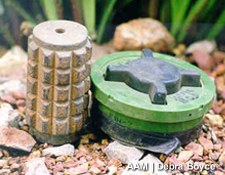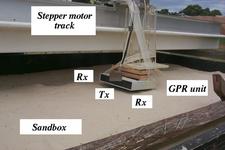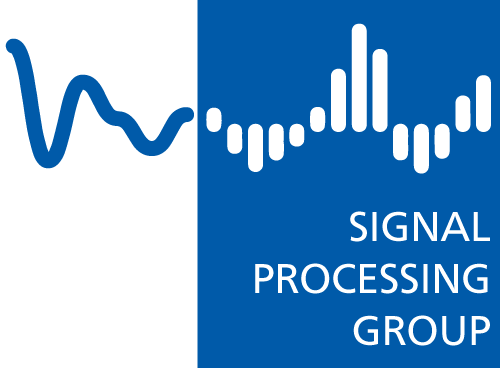Motivation

- Land mines and unexploded ordnance (UXO) kill and maim approximately 10 000 people annually – oneperson every hour – most victims are civilians living in now peaceful regions.
- Economic development is restricted through the inability to utilise potentially mined farmland and roads
- Costs three Euros to make a land mine, up to 1 000 Euros to remove
- Modern mines have minimal metal content to make them harder to detect
- Current de-mining techniques rely on manual prodding (with assistance of metal detectors), mechanical means (ploughs, flails) and specially trained dogs
High-Tech Approaches

- New techniques use sophisticated sensors and data processing to assist deminers. Hopefully this will lead to faster, more reliable and more cost-effective demining.
- Ground Penetrating Radar (GPR): Changes in the dielectric properties of the soil (e.g. caused by air gaps in the mine) can be detected. Difficult to discriminate between natural variations and those from a mine.
- Advanced metal detectors (MD): Reliability of MDs can be enhanced through analysis of induced voltage waveforms.
- Infrared (IR) cameras: Land mines absorb and release heat at different rates to the surrounding ground. IR cameras can detect changes in heat exchange during the diurnal cycle (daily variation in temperature due to heating by the sun during the day and cooling at night).
- Visual wavelength cameras: Sometimes land mines (or other explosive material) are not completely buried. When this occurs, it might be possible to detect hazards using visual images. It has also been shown that they can also be used in conjunction with IR images (see the work of Magnus Lundberg). More details of current work are provided below.
- For a very brief overview of the area, a brief slide presentation (PDF format) is available.
Detection of Partially Occluded Mines
Surface laid mines are commonly encountered -- troops often do not have time to adequately bury them and many mines are deployed from helicopters and airplanes. Unfortunately, in practice, these objects are seldom completely visible from above. Instead they are commonly partly occluded (covered). In some cases, mines are deliberately placed under bushes or in high grass. In other cases, surface laid mines may become partially occluded over time due to environmental changes, such as the movement of soil.
Hypotheses and Model
In this project, we consider images recorded in ground areas potentially containing surface laid land mines. The first hypothesis is that the image is of clutter (grass) only, while the alternative is that the image contains a partially occluded (covered) land mine in addition to the clutter. In such a scenario, the occlusion pattern is unknown and has to be treated as a nuisance parameter.
Detectors
It has already been shown that deterministic treatment of the unknown occlusion pattern, in companion with the applied model, renders a substantial increase in detector performance as compared to employment of the traditional additive model. More recent (and continuing) work has been towards incorporating knowledge of the spatial structure in the images through the use of Markov Random Fields (MRF) and median filters.
Selected SPG Publications
- M. Lundberg, C. L. Brown, and M. Uppsäll. Spatial modeling of occlusion patterns applied to the detection of surface-laid mines. In Detection and Remediation Technologies for Mines and Minelike Targets IX, volume 5415 of Proceedings of the SPIE, Orlando, USA, April 2004.
- M. Lundberg and C. L. Brown. Modelling of occluded signatures with application to optical detection of surface laid land mines. In Proceedings of the International Conference on Requirements and Technologies for the Detection, Removal and Neutralization of Landmines and UXO (EUDEM2-SCOT), Brussels, Belgium, September 2003.
- C. L. Brown, A. M. Zoubir, I.J. Chant, and C. Abeynayake. Landmine detection using single sensor metal detectors. In Proceedings of theIEEE International Conference on Acoustics, Speech and Signal Processing (ICASSP), volume 4, pages 3948-3951, Orlando FL, USA, May 2002.
- A. M. Zoubir, I. J. Chant, C. L. Brown, B. Barkat, and C. Abeynayake. Signal processing techniques for landmine detection using impulse ground penetrating radar. IEEE Sensors Journal, 2(1):41-51, February 2002.
- L. Cirillo, C. L. Brown, and A. M. Zoubir. Polynomial phase signal based detection of buried landmines using ground penetrating radar. In Proceedings of the 11thIEEE Workshop on Statistical Signal Processing (SSP), Singapore, August 2001.
- C. L. Brown, L. Cirillo, and A. M. Zoubir. Landmine detection based on non-stationary signal models. In Proceedings of the 2ndAustralian-American Joint Conference on the Technologies of Mine Countermeasures (MINWARA), Sydney, Australia, March 2001. The Mine Warfare Association.
- L. Cirillo, C. L. Brown, and A. M. Zoubir. Polynomial phase signal based detection of buried landmines using ground penetrating radar. In Proceedings of the 2ndAustralian-American Joint Conference on the Technologies of Mine Countermeasures (MINWARA), Sydney, Australia, March 2001. The Mine Warfare Association.
- A. M. Zoubir, F. Schulz, and C. L. Brown. Ground penetrating radar target classification using time-frequency analysis. In Proceedings of the 2ndAustralian-American Joint Conference on the Technologies of Mine Countermeasures (MINWARA), Sydney, Australia, March 2001. The Mine Warfare Association.
- A. M. Zoubir, B. Barkat, C. L. Brown, and I. Chant. A comparison of some landmine detection and estimation techniques using Ground Penetrating Radar. In Proceedings of the 10th Australasian Remote Sensing and Photogrammetry Conference, volume 1, page 785, Adelaide, Australia, August 2000.
- B. Barkat, A. M. Zoubir, and C. L. Brown. Application of time-frequency techniques for the detection of anti-personnel landmines. In Proceedings of the 10thIEEE Workshop on Statistical Signal and Array Processing (SSAP), pages 594-597, Pocono Manor PA, USA, August 2000.
- B. Barkat, C. L. Brown, A. M. Zoubir, and I. Chant. Time-frequency techniques for the detection of anti-personnel landmines using Ground Penetrating Radar. In Proceedings of the 10th Australasian Remote Sensing and Photogrammetry Conference, volume 1, page 726, Adelaide, Australia, August 2000.
- D. R. Iskander, A. M. Zoubir, and I. Chant. Time-Varying Spectrum Based Detection of Landmines Using Ground Penetrating Radar. In Proceedings of the 8th International Conference on Ground Penetrating Radar, volume SPIE Vol. 4084, pages 65-68, Gold Coast, Australia, May 2000.
- H. Brunzell and A. M. Zoubir. Multiple Test Procedures for Radar-Based Detection of Buried Landmines. In Proceedings of 33rd Asilomar Conference on Signals, Systems and Computers, volume 2, pages 831-834, Pacific Grove, USA, October 1999.
- A. M. Zoubir, D. R. Iskander, I. Chant, and D. Carevic. Detection of Landmines Using Ground-Penetrating Radar. In Proc. SPIE: Detection and Remediation Technologies for Mines and Minelike Targets IV, volume 3710, pages 1301-1312, Orlando, USA, August 1999
Contact: For more information on this research project contact Prof. Abdelhak M. Zoubir.


